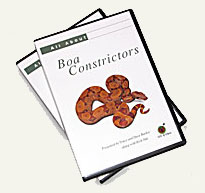Baby spotted pythons will not eat pinks...
Dear Sir and Madam,
On January 4th and 5th, we had a clutch of 9 spotted pythons hatch out. After parting with 3 for stud fees, we have 6 left. Unfortunately, despite our best efforts, we cannot get 4 of those 6 to eat. We've tried thawed pinky mice, live pinky mice, we've tried leaving live pinky mice in with the hatchlings overnight, we've tried assist feeding, and we just can't get them to eat. We've only been in the hobby for 18 months, and this is our first clutch. Obviously, we're pretty concerned at this point that we're going to lose them.
Do you have any ideas as to how we can get them to eat? Are pinky pumps worth investigating?
Incidentally, I would like to thank you both for always answering my emails. It's incredibly reassuring to be able to get advice from those individuals considered to be the best in the business. If there's ever anything you need from Australia, anything you want picked up and sent, or looked at, or any research you'd like done (I'm an excellent researcher), please, don't hesitate to ask. I'd be only too happy to help repay your invaluable advice.
Regards MV
Dear MV,
"Sir and Madam" are a little too formal for us. Don't think we are unappreciative, a little formality and courtesy are all too rare these days, but you are welcome to address us by our names.
We are sorry to hear about your babies giving you a hard time. I suspect they are lizard-eaters. That is the common food for hatchling spotted pythons and many insist on nothing else. The food preference of hatchlings is an inheritable trait and one of the things I am proud of is that as one of the earliest and most productive spotted python breeders in the US, we raised and sold babies that ate pinks. The lizard eaters didn't live to reproduce. The consequence of our and other keepers selectively breeding the mouse-eaters is that almost all spotted pythons and Children's pythons hatched today in the United States begin feeding on mice.
Something strange about baby spotted pythons is that they prefer to eat the most massive pink they can fit themselves around. Many babies will eat if they are offered something bigger than you think they possibly could eat. Don't get too carried away, of course they can't eat an adult mouse or anything like that, but they have long jaws and some of them can eat a small fuzzy as a first meal.
Mouse-eating is not in the nature of many babies, though. In the wild, the majority of hatchlings eat skinks and geckos-pink mice are a rare commodity for wild babies in nature. You can either feed them those reptiles, or you can use gecko or a skink tail to scent mice and a portion will begin to feed on those scented pinks. First thaw frozen pinks, (the tiniest you can get), wash them in unscented soap, (or just a good wash in plain water,) let them dry, and then rub them on lizards.
Also, somewhere along the way, we observed that the scent of a young carpet python is a very good trigger to get a baby Antaresia to feed. A piece of shed skin stuck on the face of a thawed, washed pink will often be accepted.
Good luck-and grow up the babies that eat mice and make them your breeders in the future and you will not have to deal with this problem with each clutch. Whenever you buy an spotted python, a children's python, or just about any species, always specify you want one that started feeding on pinks.
Also-thanks for the offer to help us with matters Australian. I have no requests right now, but it's nice to know I have someone who will help. DGB
